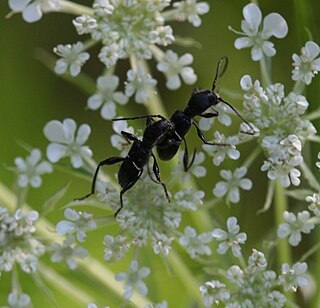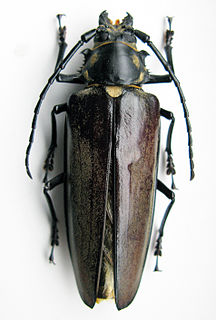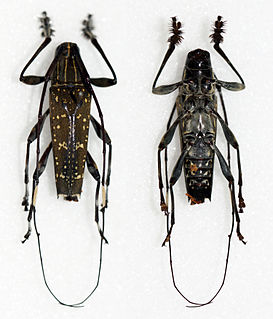Related Research Articles

The longhorn beetles (Cerambycidae), also known as long-horned or longicorns, are a large family of beetles, with over 35,000 species described. Most species are characterized by extremely long antennae, which are often as long as or longer than the beetle's body. In various members of the family, however, the antennae are quite short and such species can be difficult to distinguish from related beetle families such as the Chrysomelidae. The scientific name of this beetle family goes back to a figure from Greek mythology: after an argument with nymphs, the shepherd Cerambus was transformed into a large beetle with horns.
Edmund Francis Gilbert was an American actor, with extensive credits in both live-action roles and voice work in animation, although he was better known for the latter. He is also credited, under his birth name, with research in entomology and the discovery of new beetle species. He also replaced Phil Harris, the original voice of Baloo, in TaleSpin and for special segments featured on the VHS releases of Jungle Cubs.

The cactus mouse is a species of rodent in the family Cricetidae. It is a species of the genus Peromyscus, a closely related group of New World mice often called "deermice". They are native to desert areas of southwestern North America.

Macrodontia is an American genus of long-horned beetles remarkable for their large size and for the large mandibles of the males in particular.

The Disteniidae are a small family of beetles in the superfamily Chrysomeloidea, traditionally treated as a group within the Cerambycidae.

Euderces is a genus of longhorn beetles, family Cerambycidae. They are found in South, Central, and North America, with the centre of diversity in southern Mexico and Guatemala.

Lepturinae, the lepturine beetles, is a subfamily of the longhorn beetle family (Cerambycidae), containing about 150 genera worldwide. This lineage is most diverse in the Northern Hemisphere. Until recently the subfamily Necydalinae was included within the lepturines, but this has been recently recognized as a separate subfamily. Nine tribes are usually recognized today, with a tenth, Caraphiini, created in 2016. A few genera are of uncertain placement within the subfamily.

Anteater is a common name for the four extant mammal species of the suborder Vermilingua commonly known for eating ants and termites. The individual species have other names in English and other languages. Together with the sloths, they are within the order Pilosa. The name "anteater" is also commonly applied to the unrelated aardvark, numbat, echidnas, pangolins, and some members of the Oecobiidae, although they are not closely related to them.

Callipogon relictus is a species of longhorn beetle which is mostly found in Korea, but also in China and southern part of Russian Far East. It inhabits mixed and deciduous forests. The population of Callipogon relictus is decreasing due to deforestation and uncontrolled collection, and therefore the species are listed in the Russian Red Book.

Orthosoma is a genus of beetles in the family Cerambycidae. It is monotypic, being represented by the single species Orthosoma brunneum. The genus name Orthosoma was also previously used for a microsporidian genus. As the name is pre-occupied by this beetle genus, the name for the microsporidian has been changed to Orthosomella.

Parevander xanthomelas is a species of beetle in the family Cerambycidae. It was described by Félix Édouard Guérin-Méneville in 1844, and has been classified in the genus Parevander since the circumscription of that genus by Per Olof Christopher Aurivillius in 1912.
Rhopalophora serripennis is a species of beetle in the family Cerambycidae. It was described by Giesbert and Chemsak in 1993.

Colobothea is a genus of longhorn beetles of the subfamily Lamiinae.
Colobothea chemsaki is a species of beetle in the family Cerambycidae. It was described by Giesbert in 1979. It is known from Costa Rica and Mexico.
Colobothea rincona is a species of beetle in the family Cerambycidae. It was described by Giesbert in 1979. It is known from Costa Rica.
Colobothea sinaloensis is a species of beetle in the family Cerambycidae. It was described by Giesbert in 1979. It is known from Mexico.
Centrodera dayi is a species in the family Cerambycidae, in the order Coleoptera ("beetles"). Centrodera dayi is found in North America.
Pygoleptura brevicornis is a species of flower longhorns in the family Cerambycidae. It is found in North America.
Crossidius testaceus is a species of long-horned beetle in the family Cerambycidae. It is found in Central America and North America.

The Guianan squirrel monkey is a species of squirrel monkey from Guiana, Venezuela and Brazil. S. sciureus formerly applied to Humboldt's squirrel monkey and Collins' squirrel monkey, but genetic research in 2009 and 2015 revealed that these are distinct species.
References
- ↑ BioLib.cz - Colobothea hondurena. Retrieved on 8 September 2014.
- Edmund F. Giesbert. (1979). A Review of the Mexican and Central American Species of Colobothea Serville (Coleoptera: Cerambycidae). The Coleopterists Bulletin, 33(4), 415–438. JSTOR 4000076